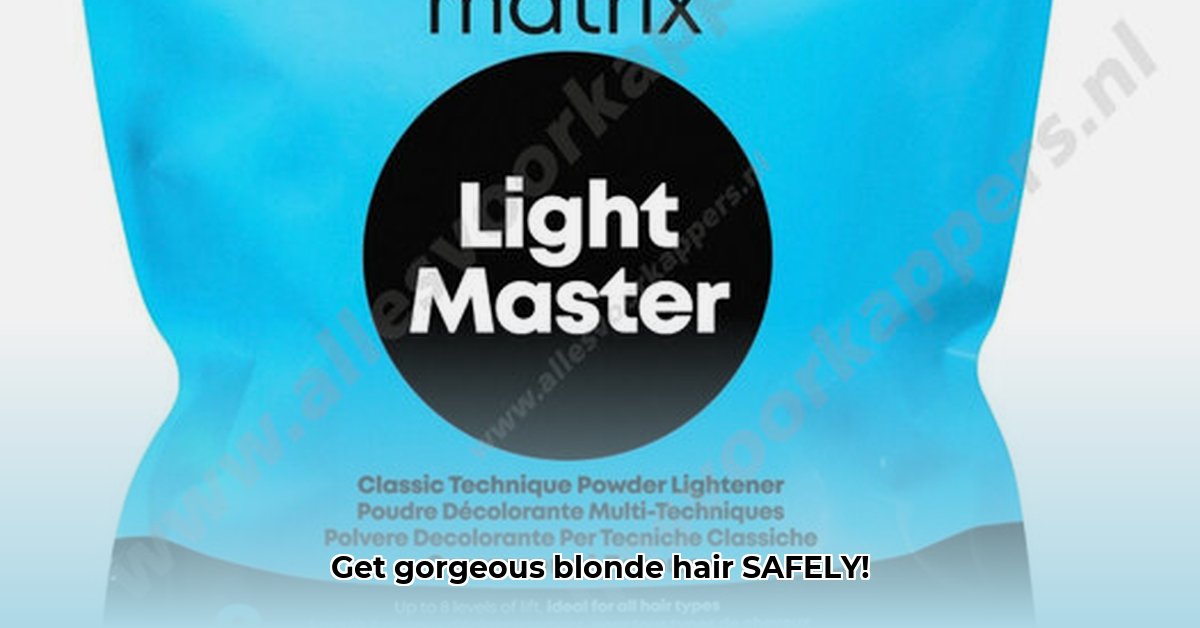
Understanding Blondeer Poeder and Hair Bleaching
Dreaming of that perfect blonde? Blondeer Poeder, a hair bleaching powder, can help you achieve it. But, going blonde isn't just about slapping on some bleach; it's about understanding the process and protecting your hair. Blondeer Poeder works by lifting the natural colour (melanin) from your hair, using a developer, usually hydrogen peroxide, to lighten it. The higher the volume of the developer, the lighter the result, but also the greater the risk of damage. (Think of it like this: a high-volume developer is a powerful tool, but needs careful handling to avoid damaging the wood you're working on).
Going Pro or DIY: Weighing Your Options
Choosing between professional and at-home bleaching is a big decision. A professional stylist expertly assesses your hair's condition, minimizing damage and ensuring even colour. This is particularly crucial if you have previously coloured or damaged hair or want a dramatic colour change. But, it's also more expensive!
At-home bleaching with Blondeer Poeder is cheaper initially, but potential mistakes can lead to costly damage repairs down the line. In addition, achieving consistent, even colour at home is a challenge.
Here's a quick comparison:
| Feature | Professional Bleaching | At-Home Bleaching with Blondeer Poeder |
|---|---|---|
| Damage Risk | Significantly lower | Higher, potentially serious damage |
| Cost | More expensive upfront | Cheaper upfront, but higher repair costs possible |
| Skill Needed | High (trained professional) | Requires research, patience, and caution |
| Colour Consistency | More even and predictable | Can be patchy and unpredictable |
| Overall Result | Better, healthier-looking hair | Risk of damage and uneven results |
DIY Blonde: A Step-by-Step Guide (Proceed with Extreme Caution!)
Disclaimer: Home bleaching carries significant risks. If you're unsure, please consult a professional stylist. This guide is for experienced users only. Improper technique can seriously damage your hair. Are you really prepared for the effort involved in making sure you protect your hair from damage?
Your At-Home Bleaching Adventure (Only if you're fully prepared):
The Strand Test (Crucial!): 24 hours before bleaching, test on a small, hidden section of hair. This checks for allergic reactions and shows how your hair responds to the mixture. (It's like a test drive before buying a car!)
Mixing It Right: Follow Blondeer Poeder instructions precisely. Correct ratios of powder to developer are crucial for safe and effective lightening. (Incorrect ratios can lead to uneven results and hair damage.)
Application Strategy: Start applying the mixture to the less visible sections (underneath) first, moving to more visible areas. Ensure even application to prevent patchy lightening. (Uneven application is a common mistake leading to inconsistent colour).
Monitoring (Essential): Regularly check for the desired lightness; aim to achieve this as quickly as possible. Stop immediately if you see any signs of breakage or excessive dryness.
The Big Rinse: Once the desired shade is reached (or if damage is noticed), rinse thoroughly with cool water. Hot water can worsen damage.
Deep Conditioning: Use a deep conditioner to repair and moisturize your hair after bleaching. (Essential for preventing dryness and breakage).
Post-Bleaching Pampering: Maintaining Healthy Blonde Hair
After bleaching, your hair needs extra TLC. Use sulfate-free shampoo and conditioner formulated for color-treated or damaged hair. Regular deep conditioning treatments are vital for maintaining moisture and shine. If you notice brassiness, use a purple toning shampoo to neutralize yellow or orange tones. Regular trims eliminate split ends, promoting healthy growth.
Troubleshooting Common Blonde Blunders
- Uneven Lightening: This usually indicates uneven application or different hair porosity.
- Brassy Tones: Use a purple toning shampoo to neutralize unwanted yellow or orange tones.
- Excessive Dryness/Brittleness: Deep conditioners and leave-in treatments are your saviours.
Remember, patience and caution are paramount. If you're ever unsure, seek professional advice. Your hair's health is the priority!
Minimizing Hair Damage When Bleaching Dark Hair at Home
"Even with careful technique, home bleaching dark hair carries substantial risks," says Dr. Anya Sharma, a leading trichologist at the Cape Town Dermatology Clinic. "A professional can accurately assess hair health and tailor the process for optimal results". Dr Sharma emphasizes the importance of regular deep conditioning treatments after bleaching to repair and strengthen damaged hair.
This section focuses on minimizing damage when bleaching dark hair at home, but remember, professional help is always the safest option, especially for very dark hair.
Pre-Bleaching Prep: Protecting Your Hair
Before bleaching, prepare your hair. Deep condition for a week or two before bleaching to enhance moisture levels. Don't wash your hair the day before to allow natural oils to act as a protective barrier. Perform a strand test 48 hours before bleaching to check for allergic reactions. If your hair has been dyed, consider using a colour remover before bleaching.
Bleaching Your Hair: A Detailed Approach
Gather Supplies: Blondeer Poeder, low-volume developer (10-20 volume), non-metallic bowl, plastic measuring cup, plastic clips, gloves, old towels, and coconut oil for your hairline.
Mix Bleach: Follow instructions carefully, using a plastic bowl and applicator.
Section Hair: Divide your hair into small sections for even application.
Apply Bleach: Start at the ends, working upwards. Avoid the scalp.
Monitor and Adjust: Check regularly (every 10-15 minutes). Processing time varies.
Rinse Thoroughly: Once the desired shade is reached, rinse with cool water.
Post-Bleaching Care: Nourishing Your Hair
Use a moisturizing deep conditioner and protein treatments regularly. Avoid heat styling and handle your hair gently.
Troubleshooting
- Uneven lightening: This might indicate uneven application or differing hair porosity.
- Brassy tones: Use a toner.
- Hair breakage: This is a sign of over-processing. Use gentle handling and deep conditioning.
Remember, patience and multiple sessions may be necessary, especially for very dark hair. Allow three weeks between bleaching sessions.